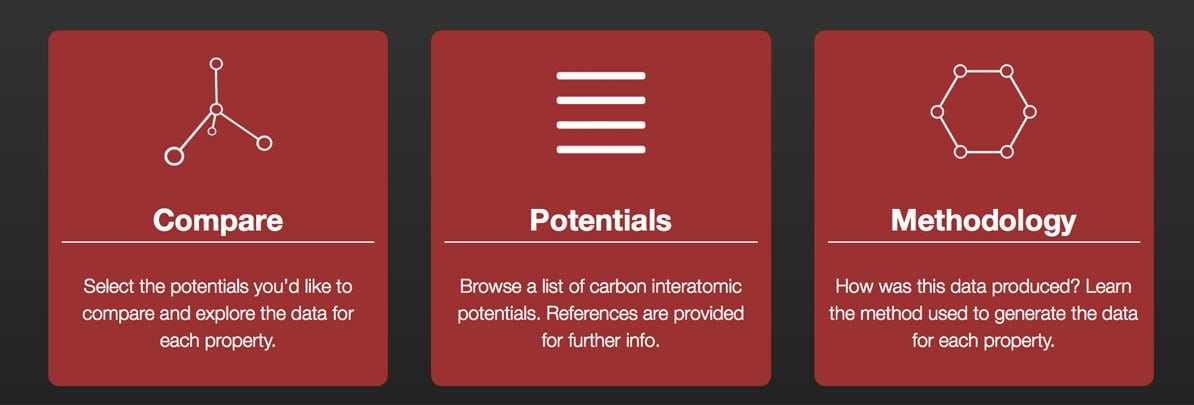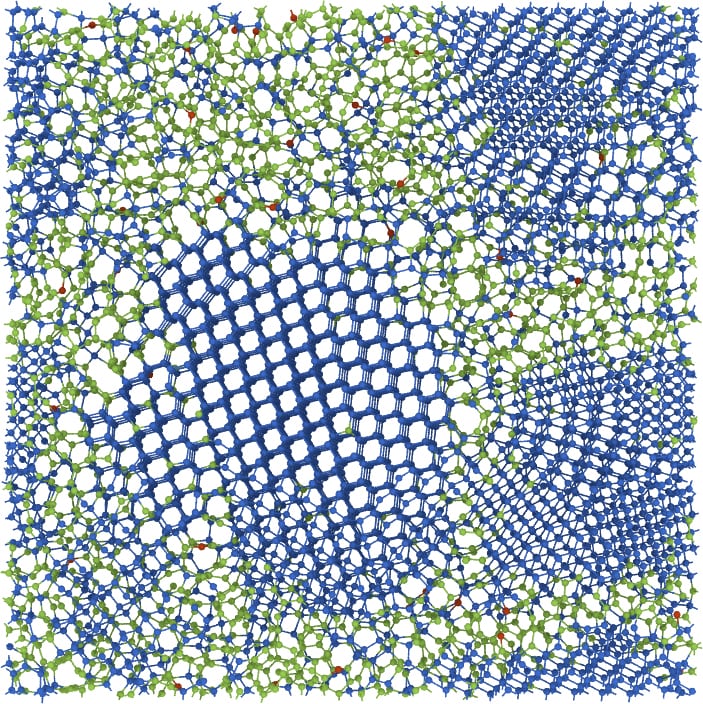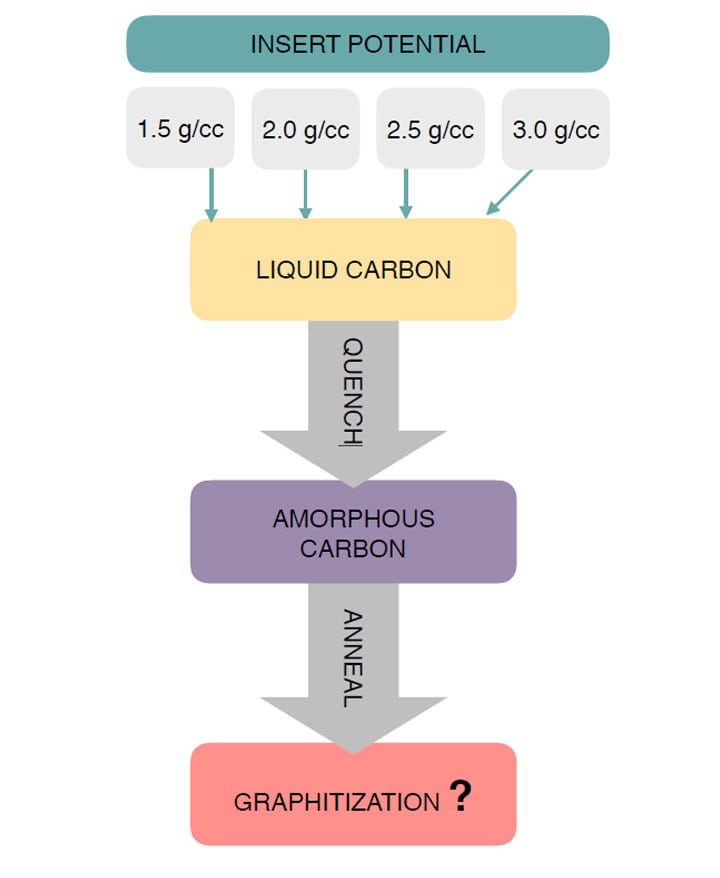Carbon Group
We are a multidisciplinary group of computational and experimentalist material scientists with different backgrounds and expertise. What links us all together is our favourite element, carbon.
Led by Associate Professor Nigel Marks, we perform experiments and simulations involving a wide range of carbon materials such as amorphous carbons, nanoporous carbons, nanodiamonds and carbides.
Honours and PhD students are part of the team every year and contribute to our research with exciting projects like the development of the Carbon Potentials interactive online tool.
Research
Online Carbon Potentials Tool
We have developed an online tool to easily compare the performance of different carbon interatomic potentials. This tool will help carbon scientists around the world to study the transferability of the potentials to ensure the reliability of the chosen potential for a given application.
We encourage other scientists to contribute their data so we can build a global carbon potentials database.

Generation of Carbide-derived Carbons
Carbide-derived carbons are a very interesting class of porous carbon materials that act as powerful selective sorbent for various molecules. This property makes them useful for a wide range of applications. A few examples are: electrode material in supercapacitors, catalyst support for fuel cells or membranes for toxic compounds removal in water, air or even in human blood.
We have simulated carbide-derived carbon structures mimicking the synthesis process with successful results and we have reproduced the graphitization process observed in the experiments.

Structural prediction of graphitization and porosity in carbide-derived carbons, Carbon 119, 1-9 (2017)
C. de Tomas, I. Suarez-Martinez, F. Vallejos-Burgos, M. J. Lopez, K. Kaneko, N. A. Marks.
Revealing the unphysical nucleation of nanodiamonds in amorphous carbons
In this work, we examine a common practice to the widely-used Tersoff potential in which the coefficient of the upper cutoff is increased either to improve properties associated with fracture or to increase the fraction of sp3 bonding in high-density amorphous carbon.
Using Molecular Dynamics simulations, we show that this so-called Extended Cutoff Tersoff model leads to nucleation of diamond nanocrystals during annealing of amorphous carbon. We quantify the precise conditions under which diamond crystallites nucleate, and present data on the radial distribution function and pressure which highlights the unphysical nature of the diamond nucleation.

Unphysical nucleation of diamond in the extended cutoff Tersoff potential, Molecular Simulation, (2017) (In press) A. Aghajamali, C. de Tomas, I. Suarez-Martinez and N. A. Marks
Which Carbon Potential should I use?
We have tested several well-known carbon potentials to check if they are able to reproduce the morphology of amorphous carbons of several densities. We have observed that not all the potentials that successfully describe other carbon allotropes as graphite or diamond are able to describe such a disordered system like the amorphous carbons.
We have also tested the ability of the different potentials to reproduce the graphitization induced by high temperature annealing of the amorphous carbons. Unexpected behaviours were unveiled.

Graphitization of amorphous carbons: A comparative study of interatomic potentials, Carbon 109, 681-693 (2016)
C. de Tomas, I. Suarez-Martinez, N. A. Marks.
Amorphous Carbon Thin films
Our lab facilities have been designed by Dr. Mark Tucker. High-power impulse magnetron sputtering (HiPIMS) is used to deposit amorphous carbon thin films.

Mixed-mode high-power impulse magnetron sputter deposition of tetrahedral amorphous carbon with pulse-length control of ionization. Journal of Applied Physics 119 (15), 155303
MD Tucker, R Ganesan, DG McCulloch, JG Partridge, M Stueber, S Ulrich, MMM Bilek, DR McKenzie, NA Marks
The behaviour of arcs in carbon mixed-mode high-power impulse magnetron sputtering, Journal of Physics D: Applied Physics,50,14,145205,2017. Tucker, MD; Putman, KJ; Ganesan, R; Lattemann, M; Stueber, M; Ulrich, S; Bilek, MMM; McKenzie, DR; Marks, NA.
Activities
- November 2020: Congratulations to Jason Fogg, who won the best oral presentation at the AIP WA student conference that took place on the 26 November at UWA.
- July 2020: We are very please to announced our latest paper in Communications Materials on Catalysis-free transformation of non-graphitising carbons into highly crystalline graphite. It is open access and you read it here.
- November 2018, Congratulations to Prof. Mauricio Terrones, recipient of the prestigious Haydn Williams Fellowship. The Carbon Group will host Mauricio next May 2019. Mauricio is a world leader in nanotechnology and Editor-in-Chief of the carbon journal. During his visit to Curtin we will organise exciting scientific and networking activities.
View the press release - November 2018, Congratulations to Mr. Andrew Thomas, 3rd year Physics student. Andrew has been selected as a Curtin HIVE intern to do research at the Carbon Group. The project ‘3D visualisation of carbon nanostructures’ will combine computer simulations and the amazing 3D visualisation facilities at HIVE to study atomistic models of activated carbons. The project will be funded by the Curtin Institute of Computation.
- October 2018, Synthesis of graphene from rice husks: our paper in collaboration with prof. Mauricio Terrones’ group has been published. Read more
- July 2018, We will present our latest results at the Carbon Conference 2018 in Madrid.
- June 2018, Our article in App.Phys. Lett. is featured as Editor’s Pick this month, have a look here: link
- June 2018, PyroMan workshop will take place in Madrid. Nigel is a invited speaker.
- 23 Feb 2018, farewell to Dr. Mark Tucker: Mark is leaving the Carbon Group to follow his career as Scientist, in the Force Standards, National Measurement Institute, Sydney.
- 30 October 2017, Congratulations to Filip Vukovic for his 1st Prize in the poster competition at MM2017.
- 27-29 September 2017, MM17 Conference
- The Molecular Modelling conference is organized by the Association of Molecular Modellers of Australasia and will be host by Curtin University in Margaret River. Carla and Alireza will participate with oral talks and Filip will present a poster.
- August 2017 Carbon Journal cover
- Carla’s image of a nanoporous carbon has been featured as front cover in the Carbon Journal Volume 120.
- 23-28 July 2017, World Carbon Conference
- Every year carbon scientist from all around the globe meet in the biggest scientific carbon-themed conference: the World Carbon Conference. This year Melbourne will host this great scientific event and Irene is a member of the scientific committee. Nigel will give a talk about carbon potentials, Carla will be talking about carbide-derived carbons and Alireza will present a poster on nanodiamond nucleation.